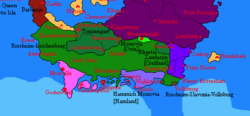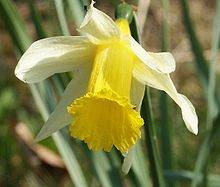Treisenberg: Difference between revisions
m (→Flora) |
m (→Flora) |
||
| Line 80: | Line 80: | ||
====Cibolan Narcissus==== | ====Cibolan Narcissus==== | ||
[[File:220px-Narcissus cibolus flower.jpg]] | [[File:220px-Narcissus cibolus flower.jpg]] | ||
The Cibolan Narcissus (Narcissus cibolus) is a native wild daffodil common to the southern half of Cibola (Germanian: Siebenbergen). It is a perennial plant that grows from a bulb and flowers annually. The plants grow best in grasslands and rocky ground, but will also grow under the cover of a light forest canopy. Cultivation of the Cibolan Narcissus has been a pastime of Treisenbergers for centuries, and an international market for the sale of bulbs has grown over the past two-hundred years. A large number of hybrids now exist thanks to the breeding of specialty cultivars. | The Cibolan Narcissus (Narcissus cibolus) is a native wild daffodil common to the southern half of Cibola (Germanian: Siebenbergen). It is a perennial plant that grows from a bulb and flowers annually. The plants grow best in grasslands and rocky ground, but will also grow under the cover of a light forest canopy. Cultivation of the Cibolan Narcissus has been a pastime of Treisenbergers for centuries, and an international market for the sale of bulbs has grown over the past two-hundred years. A large number of hybrids now exist thanks to the breeding of specialty cultivars. | ||
Revision as of 10:57, 9 October 2012
| Vereinigte Fürstentümer von Treisenberg United Principalities of Treisenberg | |||
| |||
| Motto: Unity within Diversity | |||
| Anthem: Mountain Men (Unofficial) | |||

| |||
| Map versions | 6.8.3 - 6.8.5; 7.0.0 - 7.0.1; 14.9.4 - present | ||
| Capital | Neutriesen | ||
| Largest city | Leichenberg | ||
| Official language(s) | English, German The latter is primarily ceremonial | ||
| Official religion(s) | |||
| Demonym | Treisenberger | ||
| - Adjective | Treisenbergen | ||
| Government | Monarchy | ||
| - Grand Prince | Max von Rossheim | ||
| - None | None | ||
| - Legislature | Council of Princes | ||
| Establishment | 22 December 2004 | ||
| Area | 9,728,732 km² | ||
| Population | Unknown | ||
| Active population | 4 | ||
| Currency | Treisenmark | ||
| Calendar | |||
| Time zone(s) | |||
| Mains electricity | |||
| Driving side | |||
| Track gauge | |||
| National website | None | ||
| National forum | forum | ||
| National animal | None | ||
| National food | None | ||
| National drink | None | ||
| National tree | None | ||
| Abbreviation | TRB | ||
Treisenberg, officially the United Principalities of Treisenberg (German: Die Vereinigte Fürstentümer von Treisenberg) is a nation occupying a portion of the southern half of the island of Cibola. It is a loose confederation of principalities ruled over by a Grand Prince but with nearly all legislative functions vested in the Council of Princes. The principalities are unique in that each possesses its own distinct culture, albeit many are tied by shared Germanic origins.
Etymology
Treisenberg is so named due to the geography of the mountainous terrain of Cibola. Treisen is a transliteration of treiben, the Germanian word for drive (as in livestock). The word berg is a common word for mountain. Thus Treisenberg literally means the driving mountains. The full meaning of this name is due to the association that early settlers had with shepherding, especially in the southern areas of the island where, due to the colder climate, growing crops was more difficult. Farmers would often drive their livestock, usually cattle, sheep, or goats, up the mountains in the spring when the snows began to melt. There the animals could feed on the plentiful grass growing on the mountainside until fall came and farmer's brought their livestock back down to the warmer valleys. By this designation, the name Treisenberg was not simply attributed to one area, but was a general term the Germanic peoples used for the mountains. Over time the name became associated with central and then southern Cibola, eventually lending itself to the country's name.
There has been recent argument by researchers that the word treisen is derived from reisen, a generic term applied to a series of crusades against the numerous tribes inhabiting early Cibola. Thus the name Treisenberg would be equivalent to crusader's mountain or mountain of conquest. Historians support this theory based on the early history of Treisenberg during which the young principalities, like Leichenberg, led a series of conquests against opposing tribes. There is, however, no historical record of either origin, and currently the etymology is still debated by scholars.
History
Early History
Prior to the discovery of Cibola, the island remained entirely isolated.
The First Age of Treisenberg
The founding of Treisenberg is attributed to the date of 1965 ASC (Dec 22, 2004) by Franz-Josef I. Besides Germania and San Martin, it is considered the third nation to establish itself on Cibola.
Interregnum
In 2290 ASC (Nov 12, 2005), Treisenberg passed into the hands of Stormark, albeit at a greatly reduced size with most of its mainland holdings left to fend for themselves.
The Second Age of Treisenberg
In 4775 ASC (Sept 2012) the Leichenbergers and Rhaetians met and agreed upon a basic outline for the reformation of the United Principalities; the addition of Kujirashi-Wahlstadt was made a few weeks later and rounded out the confederation.
Government and politics
Foreign relations and military
Culture
Economy
Treisenberg uses the Triesenmark as its official form of currency, and the principalities mint variants of this for use within their own boundaries. The current local units are known as: Leichenmark (Leichenberg), Liranmark (Rhaetia), Gartenmark (Triesengart), and Yenmark (Kujirashi-Wahlstadt).
Geography
Treisenberg occupies a southerly portion of the continent of Cibola, which in the local Germanian dialect is called Siebenbergen (seven mountains).
Flora
Cibolan Narcissus
The Cibolan Narcissus (Narcissus cibolus) is a native wild daffodil common to the southern half of Cibola (Germanian: Siebenbergen). It is a perennial plant that grows from a bulb and flowers annually. The plants grow best in grasslands and rocky ground, but will also grow under the cover of a light forest canopy. Cultivation of the Cibolan Narcissus has been a pastime of Treisenbergers for centuries, and an international market for the sale of bulbs has grown over the past two-hundred years. A large number of hybrids now exist thanks to the breeding of specialty cultivars.
Fauna
Siebenbergen Goats
Principalities
Treisengart
Leichenberg
Rhaetia
Officially called Rhaetia Minor, Rhaetia is a remnant of the original Principality of Rhaetia Magna, one of the original founding states of the United Principalities. During the Siebenbergen Dark Ages most of Rhaetia Magna's territory succumbed to anarchy and was annexed by neighboring Alexandria, although the royalty was able to obtain safety in a secluded valley to the south. Having settle this new valley from a literal backwoods, the royal family re-established the Rhaetian state at its new capital of Vulcuria. With the emergence of a new Treisenberg, Rhaetia came out of isolation to rejoin the United Principalities. Although only a fragment of its former glory the state is rebounding well has gained a considerable influx of population thanks both to growing families and immigrants.


